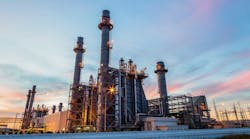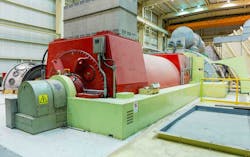Laser Scanning Accelerates Power Plant Conversions to Natural Gas
Over the past decade, more than 100 coal-fired plants have been replaced or converted to natural gas, according to the U.S. Energy Information Administration. Key factors pushing coal plant owners to make the changes include stricter emission standards, lower natural gas prices, and the emergence of Combined Cycle Gas Turbine (CCGT), a new, more efficient natural gas turbine technology.
CCGT plants are more efficient than coal plants because use the heat generated from fuel combustion to make up to 50% more electricity. First, fuel burned in the combustion chamber create combustion gases that power turbine generators to produce electricity. Then waste heat from the gas turbine, which is usually lost, gets routed to boil water to create steam to spin a steam turbine generator and generate additional electricity.
Making an effective transition to the new gas turbines calls for plant engineers to relocate sensors and emission controls on legacy turbines. To streamline that process, many plant engineers are turning to NVision Inc.’s engineering services.
“We measure the equipment using laser scanning, then create precise 3D models of the turbine assemblies for engineers to analyze for the best installation points,” says Steve Kersen, president of NVision. “This can result in huge cost and time savings for projects that would have taken much longer using less-sophisticated measurement methods. In one recent project, a southeast power plant converting to a CCGT system used our services and the output wattage increased by 35%, and they saved over $250,000 by using our services.” And converting from coal to gas should cut CO2 emissions in half.
At the start of the retrofitting process, NVision technicians visited the southeastern plant to begin the scanning process, which required several different scanners, each suited to a particular phase of the job. In the initial phase, they used NVision’s “Large Area” non-contact laser scanner to get complete scans of internal and visible external surfaces of three turbine covers and “fixed” lower housings. The scanner provided accurate measurements and geospatial data about large structures and areas.
For the turbine assemblies’ relatively smaller flange hole pattern and internal surfaces, which required more accurate data collection, they put a laser tracker to work. Like the Large Area scanner, the tracker measures over a large distance but takes discrete points of areas where high accuracy and detail is the priority.
As an object is inspected, the scanner generates a point cloud containing millions of points, each with x, y, z coordinates and i, j, k vectors. These points make up an exact duplicate of the object’s surface, down to the smallest detail. Software in the scanner converts the point cloud into an STL polygon, which is used as a template to create CAD models in IGES and STEP formats, which can be imported into any CAD software.
Measurements of other turbine components, including the drive shafts, inlet guides, stator vanes and airfoil contours, were taken using the company’s HandHeld scanner, a portable scanner capable of capturing 3D geometry from objects of almost any size or shape
All the scanning was done in three days. The data was converted into a fully aligned assembly using Siemens NX, a high-end CAD/CAM/CAE software package, which gave plant engineers 3D models of the turbine assemblies. Plant engineers analyzed the models to determine where sensors and controls could be installed and which parts or structures that needed to be redesigned for the conversion.
“The engineering services we provided to this plant and others switching to natural gas reduces the time needed to complete the conversions and illustrate the value 3D non-contact optical scanning can bring to companies,” says Kersen. The converted plant should be operational in 2023.

